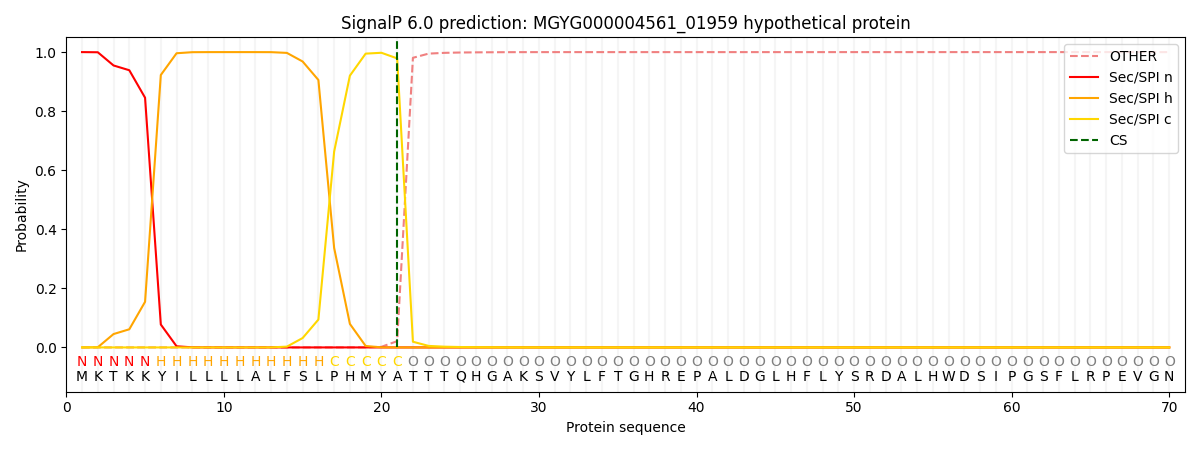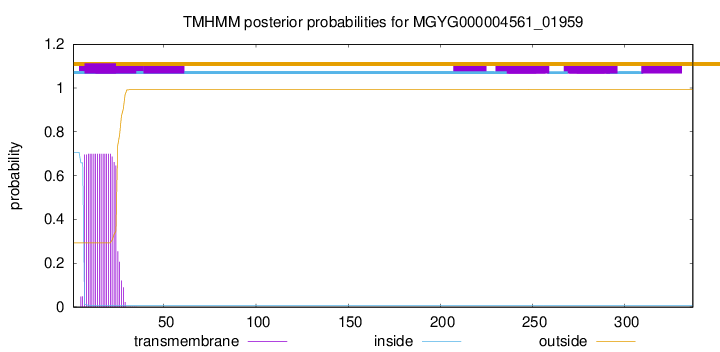You are browsing environment: HUMAN GUT
CAZyme Information: MGYG000004561_01959
You are here: Home > Sequence: MGYG000004561_01959
Basic Information |
Genomic context |
Full Sequence |
Enzyme annotations |
CAZy signature domains |
CDD domains |
CAZyme hits |
PDB hits |
Swiss-Prot hits |
SignalP and Lipop annotations |
TMHMM annotations
Basic Information help
| Species | Prevotella sp002480935 | |||||||||||
|---|---|---|---|---|---|---|---|---|---|---|---|---|
| Lineage | Bacteria; Bacteroidota; Bacteroidia; Bacteroidales; Bacteroidaceae; Prevotella; Prevotella sp002480935 | |||||||||||
| CAZyme ID | MGYG000004561_01959 | |||||||||||
| CAZy Family | GH43 | |||||||||||
| CAZyme Description | hypothetical protein | |||||||||||
| CAZyme Property |
|
|||||||||||
| Genome Property |
|
|||||||||||
| Gene Location | Start: 16740; End: 17753 Strand: - | |||||||||||
CAZyme Signature Domains help
| Family | Start | End | Evalue | family coverage |
|---|---|---|---|---|
| GH43 | 91 | 319 | 1.5e-73 | 0.9912663755458515 |
CDD Domains download full data without filtering help
| Cdd ID | Domain | E-Value | qStart | qEnd | sStart | sEnd | Domain Description |
|---|---|---|---|---|---|---|---|
| cd08983 | GH43_Bt3655-like | 3.76e-75 | 89 | 332 | 14 | 261 | Glycosyl hydrolase family 43 protein such as Bacteroides thetaiotaomicron VPI-5482 arabinofuranosidase Bt3655. This glycosyl hydrolase family 43 (GH43)-like family includes the characterized arabinofuranosidases (EC 3.2.1.55): Bacteroides thetaiotaomicron VPI-5482 (Bt3655;BT_3655) and Penicillium chrysogenum 31B Abf43B, as well as Bifidobacterium adolescentis ATCC 15703 beta-xylosidase (EC 3.2.1.37) BAD_1527. It belongs to the glycosyl hydrolase clan F (according to carbohydrate-active enzymes database (CAZY)) which includes family 43 (GH43) and 62 (GH62) families. GH43 includes enzymes with beta-xylosidase (EC 3.2.1.37), beta-1,3-xylosidase (EC 3.2.1.-), alpha-L-arabinofuranosidase (EC 3.2.1.55), arabinanase (EC 3.2.1.99), xylanase (EC 3.2.1.8), endo-alpha-L-arabinanases (beta-xylanases) and galactan 1,3-beta-galactosidase (EC 3.2.1.145) activities. GH43 are inverting enzymes (i.e. they invert the stereochemistry of the anomeric carbon atom of the substrate) that have an aspartate as the catalytic general base, a glutamate as the catalytic general acid and another aspartate that is responsible for pKa modulation and orienting the catalytic acid. Many GH43 enzymes display both alpha-L-arabinofuranosidase and beta-D-xylosidase activity using aryl-glycosides as substrates. A common structural feature of GH43 enzymes is a 5-bladed beta-propeller domain that contains the catalytic acid and catalytic base. A long V-shaped groove, partially enclosed at one end, forms a single extended substrate-binding surface across the face of the propeller. |
| cd08978 | GH_F | 3.27e-09 | 94 | 326 | 1 | 244 | Glycosyl hydrolase families 43 and 62 form CAZY clan GH-F. This glycosyl hydrolase clan F (according to carbohydrate-active enzymes database (CAZY)) includes family 43 (GH43) and 62 (GH62). GH43 includes enzymes with beta-xylosidase (EC 3.2.1.37), beta-1,3-xylosidase (EC 3.2.1.-), alpha-L-arabinofuranosidase (EC 3.2.1.55), arabinanase (EC 3.2.1.99), xylanase (EC 3.2.1.8), endo-alpha-L-arabinanases (beta-xylanases) and galactan 1,3-beta-galactosidase (EC 3.2.1.145) activities. GH62 includes enzymes characterized as arabinofuranosidases (alpha-L-arabinofuranosidases; EC 3.2.1.55) that specifically cleave either alpha-1,2 or alpha-1,3-L-arabinofuranose side chains from xylans. GH43 are inverting enzymes (i.e. they invert the stereochemistry of the anomeric carbon atom of the substrate) that have an aspartate as the catalytic general base, a glutamate as the catalytic general acid and another aspartate that is responsible for pKa modulation and orienting the catalytic acid. Many of the enzymes in this family display both alpha-L-arabinofuranosidase and beta-D-xylosidase activity using aryl-glycosides as substrates. GH62 are also predicted to be inverting enzymes. A common structural feature of both, GH43 and GH62 enzymes, is a 5-bladed beta-propeller domain that contains the catalytic acid and catalytic base. A long V-shaped groove, partially enclosed at one end, forms a single extended substrate-binding surface across the face of the propeller. |
| cd08772 | GH43_62_32_68_117_130 | 2.02e-07 | 94 | 281 | 1 | 192 | Glycosyl hydrolase families: GH43, GH62, GH32, GH68, GH117, CH130. Members of the glycosyl hydrolase families 32, 43, 62, 68, 117 and 130 (GH32, GH43, GH62, GH68, GH117, GH130) all possess 5-bladed beta-propeller domains and comprise clans F and J, as classified by the carbohydrate-active enzymes database (CAZY). Clan F consists of families GH43 and GH62. GH43 includes beta-xylosidases (EC 3.2.1.37), beta-xylanases (EC 3.2.1.8), alpha-L-arabinases (EC 3.2.1.99), and alpha-L-arabinofuranosidases (EC 3.2.1.55), using aryl-glycosides as substrates, while family GH62 contains alpha-L-arabinofuranosidases (EC 3.2.1.55) that specifically cleave either alpha-1,2 or alpha-1,3-L-arabinofuranose sidechains from xylans. These are inverting enzymes (i.e. they invert the stereochemistry of the anomeric carbon atom of the substrate) that have an aspartate as the catalytic general base, a glutamate as the catalytic general acid and another aspartate that is responsible for pKa modulation and orienting the catalytic acid. Clan J consists of families GH32 and GH68. GH32 comprises sucrose-6-phosphate hydrolases, invertases (EC 3.2.1.26), inulinases (EC 3.2.1.7), levanases (EC 3.2.1.65), eukaryotic fructosyltransferases, and bacterial fructanotransferases while GH68 consists of frucosyltransferases (FTFs) that include levansucrase (EC 2.4.1.10); beta-fructofuranosidase (EC 3.2.1.26); inulosucrase (EC 2.4.1.9), while GH68 consists of frucosyltransferases (FTFs) that include levansucrase (EC 2.4.1.10); beta-fructofuranosidase (EC 3.2.1.26); inulosucrase (EC 2.4.1.9), all of which use sucrose as their preferential donor substrate. Members of this clan are retaining enzymes (i.e. they retain the configuration at anomeric carbon atom of the substrate) that catalyze hydrolysis in two steps involving a covalent glycosyl enzyme intermediate: an aspartate located close to the N-terminus acts as the catalytic nucleophile and a glutamate acts as the general acid/base; a conserved aspartate residue in the Arg-Asp-Pro (RDP) motif stabilizes the transition state. Structures of all families in the two clans manifest a funnel-shaped active site that comprises two subsites with a single route for access by ligands. Also included in this superfamily are GH117 enzymes that have exo-alpha-1,3-(3,6-anhydro)-l-galactosidase activity, removing terminal non-reducing alpha-1,3-linked 3,6-anhydro-l-galactose residues from their neoagarose substrate, and GH130 that are phosphorylases and hydrolases for beta-mannosides, involved in the bacterial utilization of mannans or N-linked glycans. |
| cd08986 | GH43-like | 1.64e-06 | 93 | 155 | 2 | 83 | Glycosyl hydrolase family 43 protein; uncharacterized. This glycosyl hydrolase family 43 (GH43)-like subfamily includes uncharacterized enzymes similar to those with beta-1,4-xylosidase (xylan 1,4-beta-xylosidase; EC 3.2.1.37), beta-1,3-xylosidase (EC 3.2.1.-), alpha-L-arabinofuranosidase (EC 3.2.1.55), arabinanase (EC 3.2.1.99), xylanase (EC 3.2.1.8), endo-alpha-L-arabinanase and galactan 1,3-beta-galactosidase (EC 3.2.1.145) activities. These are inverting enzymes (i.e. they invert the stereochemistry of the anomeric carbon atom of the substrate) that have an aspartate as the catalytic general base, a glutamate as the catalytic general acid and another aspartate that is responsible for pKa modulation and orienting the catalytic acid. Many of the enzymes in this family display both alpha-L-arabinofuranosidase and beta-D-xylosidase activity using aryl-glycosides as substrates. A common structural feature of GH43 enzymes is a 5-bladed beta-propeller domain that contains the catalytic acid and catalytic base. A long V-shaped groove, partially enclosed at one end, forms a single extended substrate-binding surface across the face of the propeller. |
| cd08981 | GH43_Bt1873-like | 8.86e-05 | 93 | 155 | 6 | 75 | Glycosyl hydrolase family 43 protein such as Bacteroides thetaiotaomicron BT_1873. This glycosyl hydrolase family 43 (GH43) subfamily includes Bacteroides thetaiotaomicron VPI-5482 endo-arabinase (Bt1873;BT_1873), as well as uncharacterized enzymes similar to those with beta-1,4-xylosidase (xylan 1,4-beta-xylosidase; EC 3.2.1.37), beta-1,3-xylosidase (EC 3.2.1.-), alpha-L-arabinofuranosidase (EC 3.2.1.55), arabinanase (EC 3.2.1.99), xylanase (EC 3.2.1.8), endo-alpha-L-arabinanase and galactan 1,3-beta-galactosidase (EC 3.2.1.145) activities. These are inverting enzymes (i.e. they invert the stereochemistry of the anomeric carbon atom of the substrate) that have an aspartate as the catalytic general base, a glutamate as the catalytic general acid and another aspartate that is responsible for pKa modulation and orienting the catalytic acid. Many of the GH43 enzymes in this family may display both alpha-L-arabinofuranosidase and beta-D-xylosidase activity using aryl-glycosides as substrates. A common structural feature of GH43 enzymes is a 5-bladed beta-propeller domain that contains the catalytic acid and catalytic base. A long V-shaped groove, partially enclosed at one end, forms a single extended substrate-binding surface across the face of the propeller. |
CAZyme Hits help
| Hit ID | E-Value | Query Start | Query End | Hit Start | Hit End |
|---|---|---|---|---|---|
| ALK82875.1 | 7.41e-151 | 29 | 331 | 22 | 324 |
| QUT59634.1 | 3.00e-150 | 29 | 331 | 22 | 324 |
| QQY41720.1 | 3.00e-150 | 29 | 331 | 22 | 324 |
| ABR39466.1 | 1.22e-149 | 29 | 331 | 22 | 324 |
| QQY38341.1 | 1.22e-149 | 29 | 331 | 22 | 324 |
Swiss-Prot Hits help
SignalP and Lipop Annotations help
This protein is predicted as SP

| Other | SP_Sec_SPI | LIPO_Sec_SPII | TAT_Tat_SPI | TATLIP_Sec_SPII | PILIN_Sec_SPIII |
|---|---|---|---|---|---|
| 0.000237 | 0.999069 | 0.000206 | 0.000165 | 0.000152 | 0.000142 |

